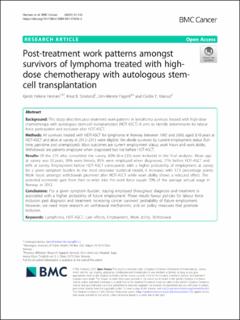| dc.contributor.author | Hernæs, Kjersti Helene | |
| dc.contributor.author | Smeland, Knut Bjøro | |
| dc.contributor.author | Fagerli, Unn-Merete | |
| dc.contributor.author | Kiserud, Cecilie E. | |
| dc.date.accessioned | 2021-04-23T11:53:53Z | |
| dc.date.available | 2021-04-23T11:53:53Z | |
| dc.date.created | 2021-04-14T15:08:16Z | |
| dc.date.issued | 2021 | |
| dc.identifier.citation | BMC Cancer. 2021, 21 (1), 1-11. | en_US |
| dc.identifier.issn | 1471-2407 | |
| dc.identifier.uri | https://hdl.handle.net/11250/2739351 | |
| dc.description.abstract | Background
This study describes post-treatment work patterns in lymphoma survivors treated with high-dose chemotherapy with autologous stem-cell transplantation (HDT-ASCT). It aims to identify determinants for labour force participation and exclusion after HDT-ASCT.
Methods
All survivors treated with HDT-ASCT for lymphoma in Norway between 1995 and 2008, aged ≥18 years at HDT-ASCT and alive at survey in 2012–2013 were eligible. We divide survivors by current employment status (full-time, part-time and unemployed). Main outcomes are current employment status, work hours and work ability. Withdrawals are patients employed when diagnosed but not before HDT-ASCT.
Results
Of the 274 who completed the survey, 82% (N = 225) were included in the final analyses. Mean age at survey was 52 years, 39% were female, 85% were employed when diagnosed, 77% before HDT-ASCT and 69% at survey. Employment before HDT-ASCT corresponds with a higher probability of employment at survey for a given symptom burden. In the most extensive statistical model, it increases with 37.3 percentage points. Work hours amongst withdrawals plummet after HDT-ASCT while work ability shows a rebound effect. The potential economic gain from their re-enter into the work force equals 70% of the average annual wage in Norway in 2012.
Conclusions
For a given symptom burden, staying employed throughout diagnosis and treatment is associated with a higher probability of future employment. These results favour policies for labour force inclusion past diagnosis and treatment increasing cancer survivors’ probability of future employment. However, we need more research on withdrawal mechanisms, and on policy measures that promote inclusion. | en_US |
| dc.language.iso | eng | en_US |
| dc.publisher | BMC | en_US |
| dc.rights | Navngivelse 4.0 Internasjonal | * |
| dc.rights.uri | http://creativecommons.org/licenses/by/4.0/deed.no | * |
| dc.title | Post-treatment work patterns amongst survivors of lymphoma treated with high-dose chemotherapy with autologous stem-cell transplantation | en_US |
| dc.type | Peer reviewed | en_US |
| dc.type | Journal article | en_US |
| dc.description.version | publishedVersion | en_US |
| dc.source.pagenumber | 1-11 | en_US |
| dc.source.volume | 21 | en_US |
| dc.source.journal | BMC Cancer | en_US |
| dc.source.issue | 1 | en_US |
| dc.identifier.doi | 10.1186/s12885-021-07836-2 | |
| dc.identifier.cristin | 1904064 | |
| cristin.ispublished | true | |
| cristin.fulltext | original | |
| cristin.qualitycode | 1 | |

